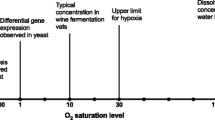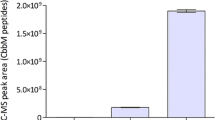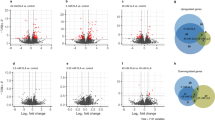Abstract
During experiments to determine the effects of exogenously added acetaldehyde on pure cultures of various yeast strains, we discovered that an early acetaldehyde perfusion during the growth phase allowed several yeasts to partially overcome the phenotypic effects of zinc depletion during alcoholic fermentation. We, therefore, performed genome-wide expression and proteomic analysis on an industrial Saccharomyces cerevisiae yeast strain (VL1) growing in zinc-replete or zinc-depleted conditions in the presence of perfused acetaldehyde to identify molecular markers of this effect. Zinc depletion severely affects ethanol production and therefore nicotinamide adenine dinucleotide (NAD) regeneration, although we observed partial compensation by the upregulation of the poorly efficient Fe-dependent Adh4p in our conditions. A coordinate metabolic response was indeed observed in response to the early acetaldehyde perfusion, and particularly of the lower part of glycolysis, leading to the cellular replenishment of NAD cofactor. These various findings suggest that acetaldehyde exchange between strains may inhibit the growth of some yeast strains while encouraging the growth of others. This phenomenon could be particularly important for understanding the ecology of colonization of complex fermentation media by S. cerevisiae after elimination of non-Saccharomyces yeasts.




Similar content being viewed by others
References
Alexandre H, Ansanay-Galeote V, Dequin S, Blondin B (2001) Global gene expression during short-term ethanol stress in Saccharomyces cerevisiae. FEBS Lett 498:98–103
Andreasson C, Ljungdahl PO (2002) Receptor-mediated endoproteolytic activation of two transcription factors in yeast. Genes Dev 16:3158–3172
Aranda A, del Olmo M (2003) Response to acetaldehyde stress in the yeast Saccharomyces cerevisiae involves a strain-dependent regulation of several ALD genes and is mediated by the general stress response pathway. Yeast 20:747–759
Aranda A, Querol A, del Olmo M (2002) Correlation between acetaldehyde and ethanol resistance and expression of HSP genes in yeast strains isolated during the biological ageing of sherry wines. Arch Microbiol 177:304–312
Barber AR, Pamment NB, Henningsson HM (2002a) Acceleration of high gravity yeast fermentations by acetaldehyde addition. Biotechnol Lett 24:891–895
Barber AR, Vriesekoop F, Pamment NB (2002b) Effects of acetaldehyde on Saccharomyces cerevisiae exposed to a range of chemical and environmental stresses. Enzyme Microb Tech 30:240–250
Beck T, Schmidt A, Hall MN (1999) Starvation induces vacuolar targeting and degradation of the tryptophan permease in yeast. J Cell Biol 146:1227–1238
Bely M, Sablayrolles JM, Barre P (1990) Description of alcoholic fermentation kinetics: its variability and significance. Am J Enol Vitic 40:319–324
Bonnemaire JP (1972) Dosage de divers métaux du vin: calcium, magnésium, zinc, cuivre, fer, plomb. PhD, Pharmacie, Université Montpellier I, Montpellier, France
Boucherie H, Bataille N, Fitch IT, Perrot M, Tuite MF (1995) Differential synthesis of glyceraldehyde-3-phosphate dehydrogenase polypeptides in stressed yeast cells. FEMS Microbiol Lett 125:127–133
Boy-Marcotte E, Perrot M, Bussereau F, Boucherie H, Jacquet M (1998) Msn2p and Msn4p control a large number of genes induced at the diauxic transition which are repressed by cyclic AMP in Saccharomyces cerevisiae. J Bacteriol 180:1044–1052
Brachmann CB, Davies A, Cost GJ, Caputo E, Li J, Hieter P, Boeke JD (1998) Designer deletion strains derived from Saccharomyces cerevisiae S288C: a useful set of strains and plasmids for PCR-mediated gene disruption and other applications. Yeast 14:115–132
Bradford MM (1976) A rapid and sensitive method for the quantitation of microgram quantities of protein utilizing the principle of protein-dye binding. Anal Biochem 72:248–254
Bromberg SK, Bower PA, Duncombe GR, Fehring J, Gerber L, Lau VK, Tata M (1997) Requirements for zinc, manganese, calcium, and magnesium in wort. J Am Soc Brew Chem 55:123–128
Buu LM, Chen YC, Lee FJ (2003) Functional characterization and localization of acetyl-CoA hydrolase, Ach1p, in Saccharomyces cerevisiae. J Biol Chem 278:17203–17209
Cavalieri D, Barberio C, Casalone E, Pinzauti F, Sebastiani F, Mortimer RK, Polsinelli M (1998) Genetic and molecular diversity in S. cerevisiae natural populations. Food Technol Biotechnol 36:45–50
Cheraiti N, Guezenec S, Salmon JM (2005) Redox interactions between Saccharomyces cerevisiae and Saccharomyces uvarum in mixed culture under enological conditions. Appl Environ Microbiol 71:255–260
Christensen P, Kasimatis AN (1967) Correction of vineyard zinc deficiency by soil injection of zinc sulfate solutions. Am J Enol Vitic 18:217–224
de Smidt O, Albertyn J, du Preez JC (2007) Molecular and physiological aspects of alcohol dehydrogenases in Saccharomyces cerevisiae. Proceedings of the 26th International Specialized Symposium on yeasts (ISSY 26), Agricultural faculty, university of Basilicata, Potenza, Italy
Delgado ML, O, Connor JE, Azorín I, Renau-Piqueras J, Gil ML, Gozalbo D (2001) The glyceraldehyde-3-phosphate dehydrogenase polypeptides encoded by the Saccharomyces cerevisiae TDH1, TDH2 and TDH3 genes are also cell wall proteins. Microbiology 147:411–417
Didion T, Regenberg B, Jorgensen MU, Kielland-Brandt MC, Andersen HA (1998) The permease homologue Ssy1p controls the expression of amino acid and peptide transporter genes in Saccharomyces cerevisiae. Mol Microbiol 27:643–650
Drewke C, Ciriacy M (1988) Overexpression, purification and properties of alcohol dehydrogenase IV from Saccharomyces cerevisiae. Biochim Biophys Acta 950:54–60
Egli CM, Edinger WD, Mitrakul CM, Henick-Kling T (1998) Dynamics of indigenous and inoculated yeast populations and their effect on the sensory character of Riesling and Chardonnay wines. J Appl Microbiol 85:779–789
Eide J (2005) Aap1 activation domain 1 and its role in controlling gene expression in response to cellular zinc status. Mol Microbiol 57:834–846
Finkelstein D, Ewing R, Gollub J, Sterky F, Cherry JM, Somerville S (2002) Microarray data quality analysis: lessons from the AFGC project. Plant Mol Biol 48:119–131
Flikweert MT (1999) Physiological roles of pyruvate decarboxylase in Saccharomyces cerevisiae. PhD, Delft University of Technology, Delft, Netherlands
Gasch AP, Spellman PT, Kao CM, Carmel-Harel O, Eisen MB, Storz G, Botstein D, Brown PO (2000) Genomic expression programs in the response of yeast cells to environmental changes. Mol Biol Cell 11:4241–4257
Gonzalez B, Francois J, Renaud M (1997) A rapid and reliable method for metabolite extraction in yeast using boiling buffered ethanol. Yeast 13:1347–1355
Herbig A, Bird AJ, Swierczek S, McCall K, Mooney M, Wu C, Winge DR, Lyons D, Thomas J (2000) Genome-wide characterization of the Zap1p zinc-responsive regulon in yeast. Proc Natl Acad Sci U S A 97:7957–7962
Higgins VJ, Rogers PJ, Dawes IW (2003) Application of genome-wide expression analysis to identify molecular markers useful in monitoring industrial fermentations. Appl Environ Microbiol 69:7535–7540
Iraqui I, Vissers S, Bernard F, de Craene JO, Boles E, Urrestarazu A, Andre B (1999) Amino acid signaling in Saccharomyces cerevisiae: a permease-like sensor of external amino acids and F-Box protein Grr1p are required for transcriptional induction of the AGP1 gene, which encodes a broad-specificity amino acid permease. Mol Cell Biol 19:989–1001
Jensen ON, Wilm M, Shevchenko A, Mann M (1999) Sample preparation methods for mass spectrometric peptide mapping directly from 2-D electrophoresis gels. Methods Mol Biol 112:513–530
Kreder GC (1999) Yeast assimilation of trub-bound zinc. J Am Soc Brew Chem 57:129–132
Liu SQ, Pilone GJ (2000) An overview of formation and roles of acetaldehyde in winemaking with emphasis on microbiological implications. Int J Food Sci Technol 35:49–61
Lyons TJ, Gasch AP, Gaither LA, Botsein D, Brown PO, Eide DJ (2000) Genome-wide characterization of the Zap1p zinc-responsive regulon in yeast. Proc Natl Acad Sci USA 97:7957–7962
Mac Diarmid CW, Gaither LA, Eide D (2000) Zinc transporters that regulate vacuolar zinc storage in Saccharomyces cerevisiae. EMBO J 19:2845–2855
Magasanik B, Kaiser CA (2002) Nitrogen regulation in Saccharomyces cerevisiae. Gene 290:1–18
McAlister L, Holland MJ (1985a) Differential expression of the three yeast glyceraldehyde-3-phosphate dehydrogenase genes. J Biol Chem 260:15019–15027
McAlister L, Holland MJ (1985b) Isolation and characterization of yeast strains carrying mutations in the glyceraldehyde-3-phosphate dehydrogenase genes. J Biol Chem 260:15013–15018
Neuhoff V, Arold N, Taube D, Ehrhardt W (1988) Improved staining of proteins in polyacrylamide gels including isoelectric focusing gels with clear background at nanogram sensitivity using Coomassie Brilliant Blue G-250 and R-250. Electrophoresis 9:255–262
Nivinskas H, Cole KD (1996) Environmentally benign staining procedure for electrophoresis gels using Coomassie Brilliant Blue. Biotechniques 20:380–384
O’Dell BL (1984) Bioavailability of trace elements. Nutr Rev 42:301–308
Omura F, Kodama Y, Ashikari T (2001) The N-terminal domain of the yeast permease Bap2p plays a role in its degradation. Biochem Biophys Res Commun 287:1045–1050
Pigeau GM, Inglis DL (2005) Upregulation of ALD3 and GPD1 in Saccharomyces cerevisiae during Icewine fermentation. J Appl Microbiol 99:112–125
Rosenfeld E, Beauvoit B, Blondin B, Salmon JM (2003) Oxygen consumption by anaerobic Saccharomyces cerevisiae under enological conditions: effect on fermentation kinetics. Appl Environ Microbiol 69:113–121
Rossignol T, Dulau L, Julien A, Blondin B (2003) Genome-wide monitoring of wine yeast gene expression during alcoholic fermentation. Yeast 19:1299–1321
Roustan JL, Sablayrolles JM (2002a) Impact of the addition of electron acceptors on the by-products of alcoholic fermentation. Enzyme Microb Technol 34:142–152
Roustan JL, Sablayrolles JM (2002b) Modification of the acetaldehyde concentration during alcoholic fermentation and effects on fermentation kinetics. J Biosci Bioeng 93:367–375
Sablayrolles JM, Barre P, Grenier P (1987) Design of a laboratory automatic system for studying alcoholic fermentations in anisothermal enological conditions. Biotechnol Tech 1:181–184
Salmon JM (1989) Effect of sugar transport inactivation in Saccharomyces cerevisiae on sluggish and stuck enological fermentations. Appl Environ Microbiol 55:953–958
Sauvage FX, Pradal M, Chatelet P, Tesniere C (2007) Proteome changes in leaves from grapevine (Vitis vinifera L.) transformed for alcohol dehydrogenase activity. J Agric Food Chem 55:2597–2603
Stanbrough M, Magasanik B (1995) Transcriptional and posttranslational regulation of the general amino acid permease of Saccharomyces cerevisiae. J Bacteriol 177:94–102
Stanley GA, Douglas NG, Every EJ, Tzanatos T, Pamment NB (1993) Inhibition and stimulation of yeast growth by acetaldehyde. Biotechnol Lett 15:1199–1204
Stanley GA, Hobley TJ, Pamment NB (1997) Effect of acetaldehyde on Saccharomyces cerevisiae and Zymomonas mobilis subjected to environmental shocks. Biotechnol Bioeng 53:71–78
Tseng GC, Oh MK, Rohlin L, Liao JC, Wong WH (2001) Issues in cDNA microarray analysis: quality filtering, channel normalization, models of variations and assessment of gene effects. Nucleic Acids Res 57:383–401
Vallee H, Bert L, Falchuk KH (1993) The biochemical basis of zinc physiology. Physiol Rev 73:99–104
Villanova M, Martinez C, Siero C, Masneuf I, Dubourdieu D (2003) Ecology of Saccharomyces cerevisiae fermentations at a Rias Baixas appellation contrôlée winery. J Inst Brew 109:305–308
Walker-Caprioglio HM, Parks LW (1987) Autoconditioning factor relieves ethanol-induced growth inhibition of Saccharomyces cerevisiae. Appl Environ Microbiol 53:33–35
Zhao H, Eide DJ (1996a) The yeast ZRT1 gene encodes the zinc transporter protein of a high-affinity uptake system induced by zinc depletion. Proc Natl Acad Sci U S A 93:2454–2458
Zhao H, Eide DJ (1996b) The ZRT2 gene encodes the low affinity zinc transporter in Saccharomyces cerevisiae. J Biol Chem 271:23203–23210
Zhao H, Eide DJ (1997) Zap1p, a metalloregulatory protein involved in zinc-responsive transcriptional regulation in Saccharomyces cerevisiae. Mol Cell Biol 17:5044–5052
Acknowledgment
P. Delobel’s expert technical assistance is gratefully acknowledged for microarray analysis. N. Cheraiti was the recipient of a grant from the Ministère de la Recherche et de l’Enseignement Supérieur.
Author information
Authors and Affiliations
Corresponding author
Rights and permissions
About this article
Cite this article
Cheraiti, N., Sauvage, FX. & Salmon, JM. Acetaldehyde addition throughout the growth phase alleviates the phenotypic effect of zinc deficiency in Saccharomyces cerevisiae . Appl Microbiol Biotechnol 77, 1093–1109 (2008). https://doi.org/10.1007/s00253-007-1234-z
Received:
Revised:
Accepted:
Published:
Issue Date:
DOI: https://doi.org/10.1007/s00253-007-1234-z




